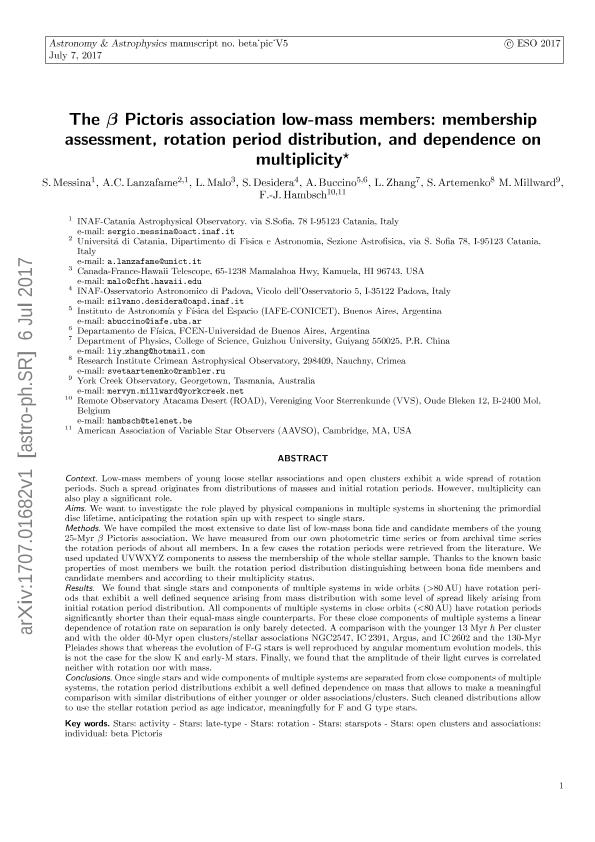Mostrar el registro sencillo del ítem
dc.contributor.author
Messina, S.
dc.contributor.author
Lanzafame, A. C.
dc.contributor.author
Malo, L.
dc.contributor.author
Desidera, S.
dc.contributor.author
Buccino, Andrea Paola

dc.contributor.author
Zhang, L.
dc.contributor.author
Artemenko, S.
dc.contributor.author
Millward, M.
dc.contributor.author
Hambsch, F.-J.
dc.date.available
2018-10-31T17:20:18Z
dc.date.issued
2017-11
dc.identifier.citation
Messina, S.; Lanzafame, A. C.; Malo, L.; Desidera, S.; Buccino, Andrea Paola; et al.; The β Pictoris association low-mass members: Membership assessment, rotation period distribution, and dependence on multiplicity; EDP Sciences; Astronomy and Astrophysics; 607; A3; 11-2017; 1-17
dc.identifier.issn
0004-6361
dc.identifier.uri
http://hdl.handle.net/11336/63388
dc.description.abstract
Context. Low-mass members of young loose stellar associations and open clusters exhibit a wide spread of rotation periods. Such a spread originates from the distributions of masses and initial rotation periods. However, multiplicity can also play a significant role. Aims. We aim to investigate the role played by physical companions in multiple systems in shortening the primordial disk lifetime, anticipating the rotation spin up with respect to single stars. Methods. We have compiled the most extensive list to date of low-mass bona fide and candidate members of the young 25-Myr β Pictoris association. We have measured from our own photometric time series or from archival time series the rotation periods of almost all members. In a few cases the rotation periods were retrieved from the literature. We used updated UVWXYZ components to assess the membership of the whole stellar sample. Thanks to the known basic properties of most members we built the rotation period distribution distinguishing between bona fide members and candidate members and according to their multiplicity status. Results. We find that single stars and components of multiple systems in wide orbits (>80 AU) have rotation periods that exhibit a well defined sequence arising from mass distribution with some level of spread likely arising from initial rotation period distribution. All components of multiple systems in close orbits (<80 AU) have rotation periods that are significantly shorter than their equal-mass single counterparts. For these close components of multiple systems a linear dependence of rotation rate on separation is only barely detected. A comparison with the younger 13 Myr h Per cluster and with the older 40-Myr open clusters and stellar associations NGC 2547, IC 2391, Argus, and IC 2602 and the 130-Myr Pleiades shows that whereas the evolution of F-G stars is well reproduced by angular momentum evolution models, this is not the case for the slow K and early-M stars. Finally, we find that the amplitude of their light curves is correlated neither with rotation nor with mass. Conclusions. Once single stars and wide components of multiple systems are separated from close components of multiple systems, the rotation period distributions exhibit a well defined dependence on mass that allows us to make a meaningful comparison with similar distributions of either younger or older associations and clusters. Such cleaned distributions allow us to use the stellar rotation period meaningfully as an age indicator for F and G type stars.
dc.format
application/pdf
dc.language.iso
eng
dc.publisher
EDP Sciences

dc.rights
info:eu-repo/semantics/openAccess
dc.rights.uri
https://creativecommons.org/licenses/by-nc-sa/2.5/ar/
dc.subject
Binaries: Close
dc.subject
Open Clusters And Associations: Individual: ΒPictoris
dc.subject
Stars: Activity
dc.subject
Stars: Late-Type
dc.subject
Stars: Rotation
dc.subject
Starspots
dc.subject.classification
Astronomía

dc.subject.classification
Ciencias Físicas

dc.subject.classification
CIENCIAS NATURALES Y EXACTAS

dc.title
The β Pictoris association low-mass members: Membership assessment, rotation period distribution, and dependence on multiplicity
dc.type
info:eu-repo/semantics/article
dc.type
info:ar-repo/semantics/artículo
dc.type
info:eu-repo/semantics/publishedVersion
dc.date.updated
2018-10-23T18:11:22Z
dc.journal.volume
607
dc.journal.number
A3
dc.journal.pagination
1-17
dc.journal.pais
Francia

dc.journal.ciudad
Paris
dc.description.fil
Fil: Messina, S.. Osservatorio Astrofisico Di Catania; Italia
dc.description.fil
Fil: Lanzafame, A. C.. Universita Degli Studi Di Catania; Italia
dc.description.fil
Fil: Malo, L.. Canada France Hawaii Telescope Corporation; Canadá
dc.description.fil
Fil: Desidera, S.. Osservatorio Astronomico Di Padova; Italia
dc.description.fil
Fil: Buccino, Andrea Paola. Universidad de Buenos Aires; Argentina. Consejo Nacional de Investigaciónes Científicas y Técnicas. Oficina de Coordinación Administrativa Ciudad Universitaria. Instituto de Astronomía y Física del Espacio. - Universidad de Buenos Aires. Facultad de Ciencias Exactas y Naturales. Instituto de Astronomía y Física del Espacio; Argentina
dc.description.fil
Fil: Zhang, L.. Guizhou University; China
dc.description.fil
Fil: Artemenko, S.. Crimean Astrophysical Observatory; Australia
dc.description.fil
Fil: Millward, M.. York Creek Observatory Georgetown; Australia
dc.description.fil
Fil: Hambsch, F.-J.. American Association Of Variable Star Observers; Estados Unidos
dc.journal.title
Astronomy and Astrophysics

dc.relation.alternativeid
info:eu-repo/semantics/altIdentifier/doi/http://dx.doi.org/10.1051/0004-6361/201730444
Archivos asociados
